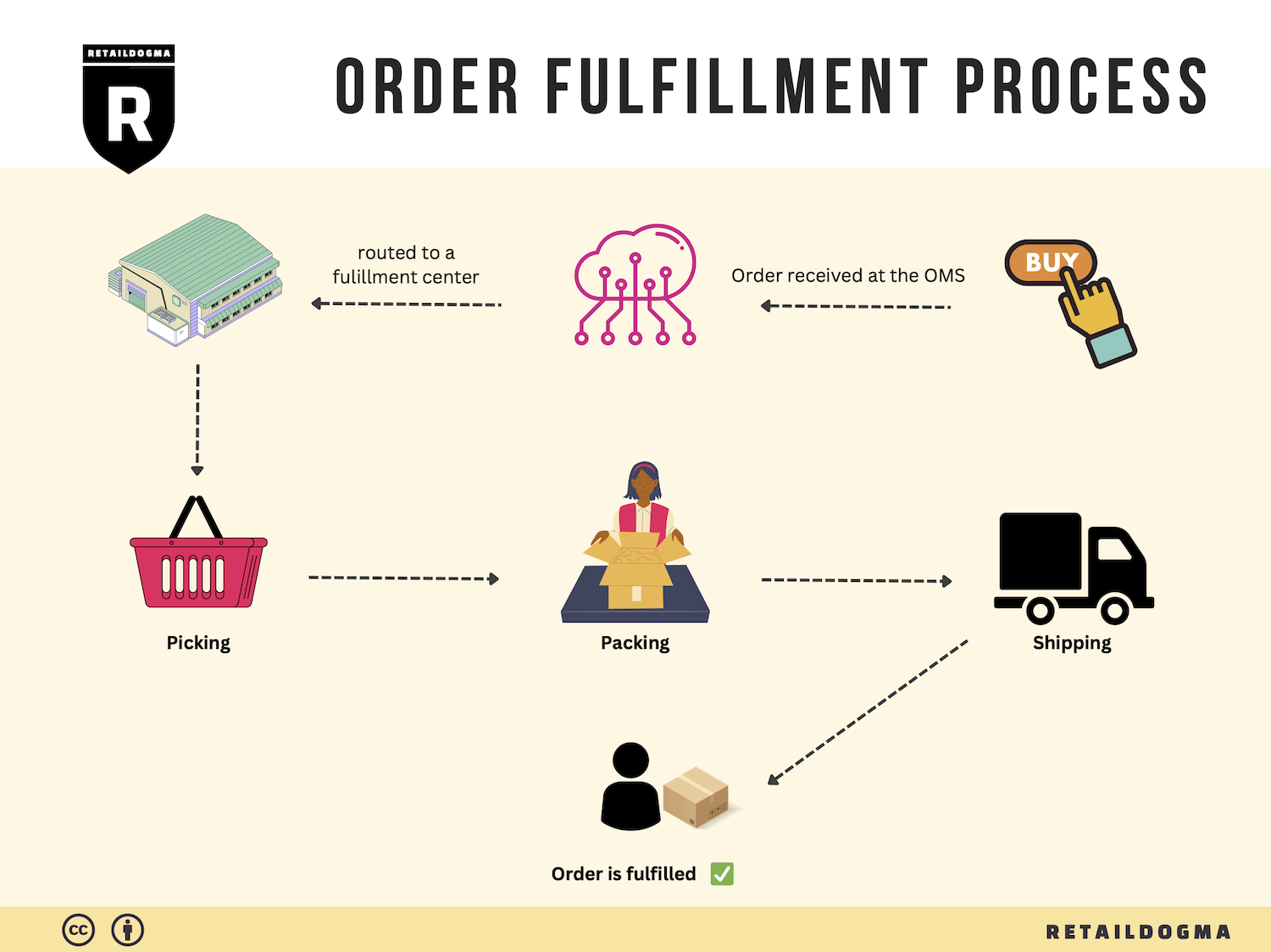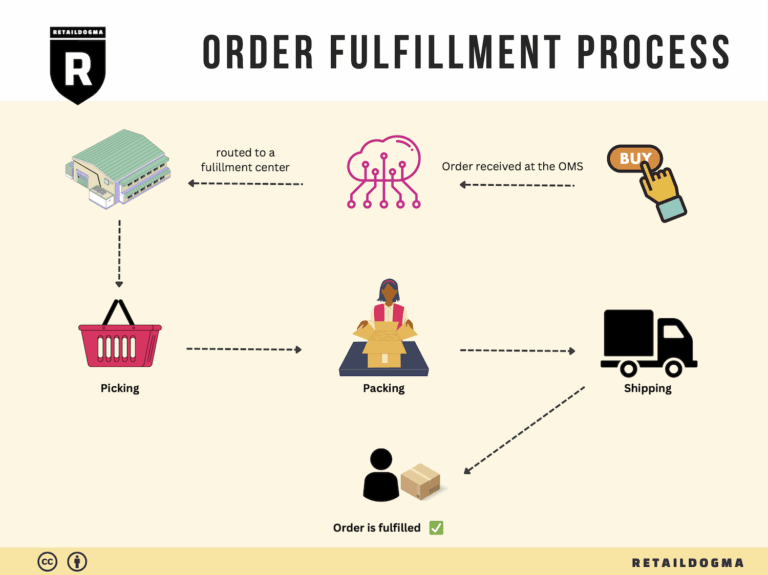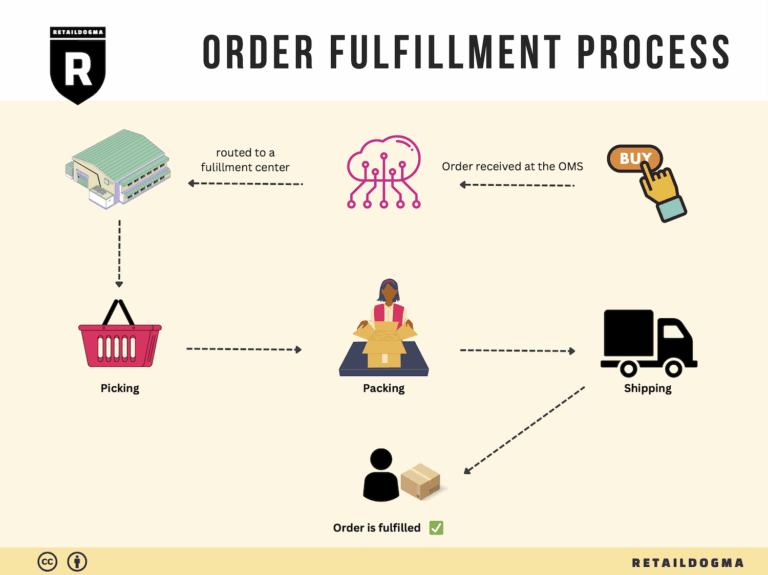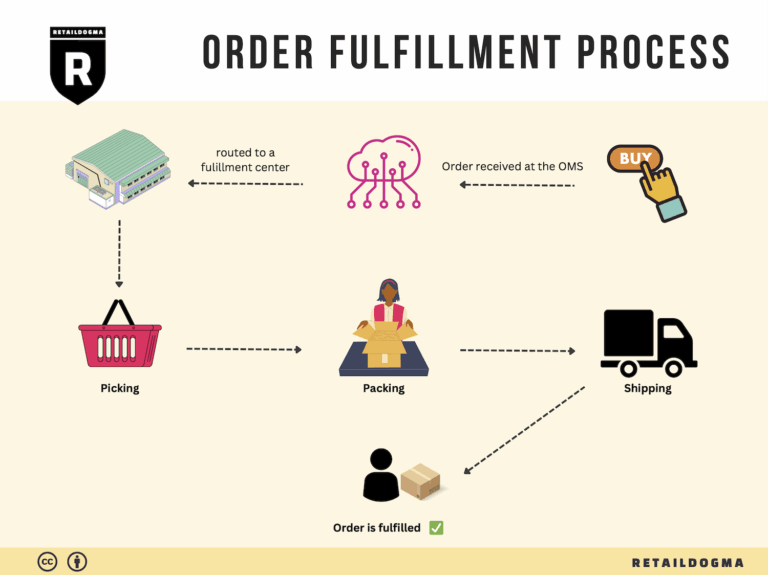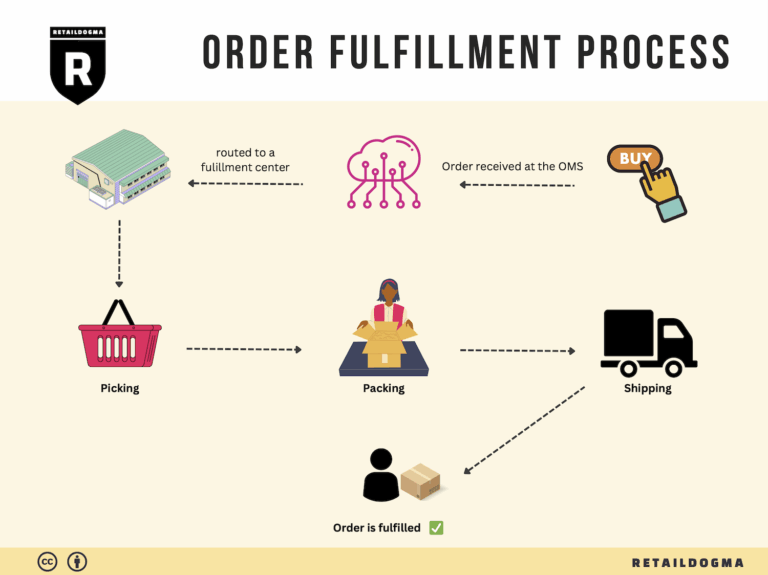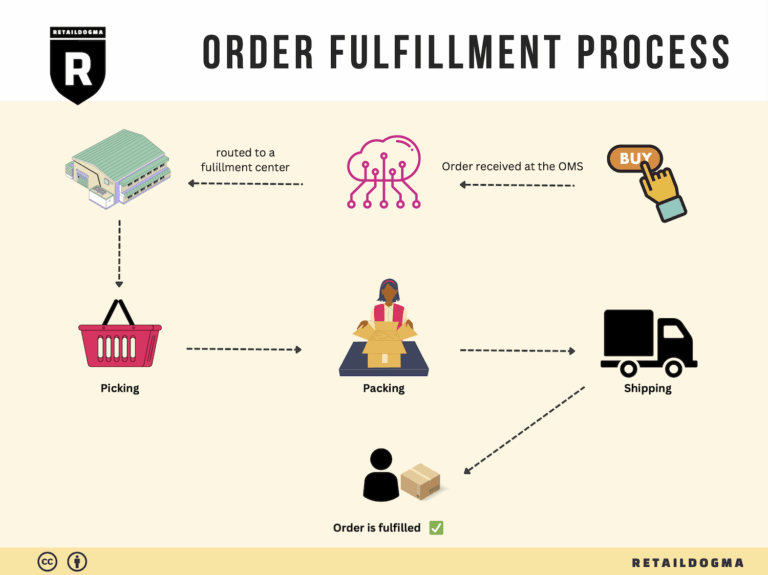How Order Fulfillment Works: A Step-by-Step Guide for Businesses
What is E-commerce Fulfillment? An Introduction for Growing Businesses
Understanding the Fulfillment Challenge
As an e-commerce business owner, you might find yourself grappling with the overwhelming task of packing and shipping orders. This process, while essential, can quickly become a bottleneck as your sales grow. Managing inventory, ensuring timely deliveries, and maintaining customer satisfaction can feel daunting. The good news? You’re not alone, and there are effective solutions available.
Fulfillment, at its core, is the process of getting a product from your warehouse or storage facility to your customer’s doorstep. It encompasses everything from receiving orders and picking items to packing them for shipment and handling returns. For many growing businesses, the question becomes not just how to fulfill orders, but how to do so efficiently and cost-effectively.
In this guide, we will explore the various fulfillment models available to e-commerce businesses, including third-party logistics (3PL) and Fulfillment by Amazon (FBA). Each model has its own set of advantages and challenges, and understanding these can help you decide which aligns best with your business goals.
We’ll delve into the core services essential for an effective fulfillment operation. This includes inventory management, order processing, and logistics—each of which plays a crucial role in ensuring your customers receive their orders accurately and on time.
Choosing the right fulfillment partner is another critical aspect we’ll cover. Factors such as scalability, technology integration, and capabilities should influence your decision, as the right partner can significantly enhance your operational efficiency and customer experience.

Lastly, we will address the important topic of pricing. Understanding the costs associated with fulfillment—from setup and storage fees to shipping costs—is vital for maintaining healthy profit margins as you scale your business.
The ultimate goal of this guide is to empower you with the knowledge and tools necessary to make informed decisions about your logistics. By optimizing your fulfillment strategy, you can focus on what truly matters: growing your business and delighting your customers.
What You’ll Learn In This Guide
- What is E-commerce Fulfillment? An Introduction for Growing Businesses
- The Order Fulfillment Process: From ‘Buy’ Button to Customer’s Door
- Comparing Fulfillment Models: In-House vs. 3PL vs. Dropshipping
- A Deep Dive into Amazon FBA: Pros, Cons, and Who It’s For
- Core Services Offered by Fulfillment Centers
- How to Choose a Fulfillment Partner: A 6-Point Checklist
- Understanding Fulfillment Pricing: A Breakdown of Common Fees
- Frequently Asked Questions (FAQs) about Fulfillment
- Conclusion: Is Outsourcing Fulfillment the Right Move for Your Business?
- Important Disclaimer
The Order Fulfillment Process: From ‘Buy’ Button to Customer’s Door
1. Receiving Inventory
The order fulfillment process begins with receiving inventory, which involves accepting goods from suppliers and verifying their quality and quantity against purchase orders. This step is crucial as it sets the foundation for the entire fulfillment operation. Each item received is assigned a Stock Keeping Unit (SKU), a unique identifier that helps track inventory throughout the supply chain.
Proper receiving procedures include inspecting the condition of items, checking for discrepancies in quantity, and recording the received products in the inventory management system. This step is essential to minimize errors and ensure that the inventory levels are accurate, which is vital for meeting customer demand and avoiding stockouts.
2. Warehouse Storage
Once inventory is received, the next step is warehouse storage. This involves organizing products in a manner that optimizes space and facilitates easy access for picking. Efficient storage strategies, such as using bin locations or shelf labels, help streamline the retrieval process.
The importance of this step lies in its impact on the overall efficiency of the fulfillment operation. Properly organized inventory not only reduces the time it takes to locate items but also minimizes the risk of errors during order picking. Implementing a robust Warehouse Management System (WMS) can enhance visibility into inventory levels and locations, allowing for better planning and inventory control.
3. Order Picking
Order picking is the process of selecting items from the warehouse to fulfill customer orders. This step typically involves using pick lists, which are generated based on customer orders and guide warehouse staff in retrieving the correct items. Efficient picking methods, such as batch picking or zone picking, can significantly enhance productivity.
The significance of this step cannot be overstated, as it directly affects order accuracy and fulfillment speed. Errors during picking can lead to customer dissatisfaction and increased return rates. By leveraging technology, such as barcode scanners or mobile devices, businesses can streamline the picking process and reduce the likelihood of mistakes, ultimately improving customer experience.
4. Order Packing
After items have been picked, the next phase is order packing. This involves carefully packing the selected products into boxes or envelopes, ensuring they are secure and protected during transit. This step is critical for minimizing damage and ensuring that customers receive their orders in excellent condition.
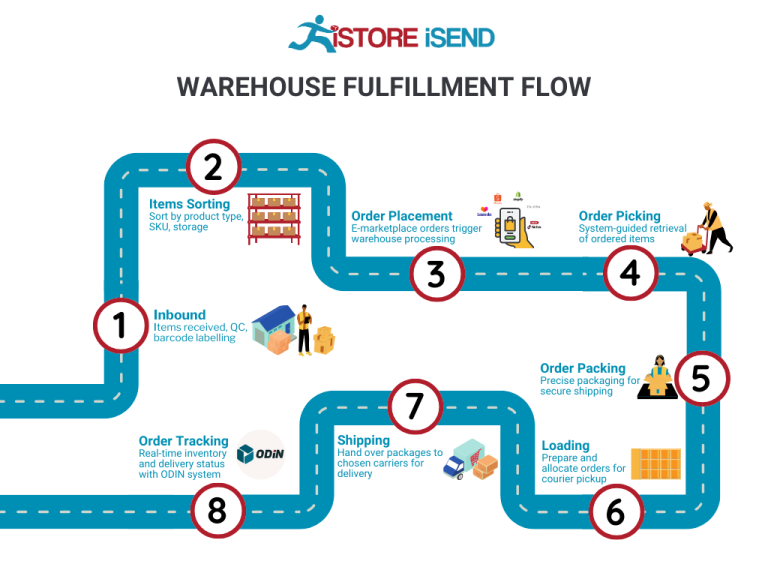
Proper packing procedures include choosing the right box size, using appropriate packing materials, and including necessary documentation, such as packing slips or invoices. The packing process is also an opportunity to enhance the customer experience—using branded packaging or including a thank-you note can leave a positive impression. Additionally, businesses must track packing data to maintain accurate inventory levels and facilitate returns if necessary.
5. Shipping & Delivery
The final step in the fulfillment process is shipping and delivery. Once orders are packed, they are labeled and handed over to shipping carriers for transport to the customer. This stage is vital as it influences delivery speed, a key factor in customer satisfaction.
Choosing the right shipping method and carrier is essential for balancing cost and delivery time. Businesses often utilize shipping software to optimize routes and track shipments in real-time, providing customers with updates on their order status. Effective shipping strategies can also involve offering multiple shipping options to customers, allowing them to select their preferred delivery speed.
In conclusion, mastering the order fulfillment process from receiving inventory to shipping and delivery is crucial for e-commerce businesses aiming to scale operations and enhance customer satisfaction. Each step plays a pivotal role in ensuring that products are delivered accurately and promptly, ultimately contributing to the overall success of the business. By investing in technology and refining processes, e-commerce entrepreneurs can create a seamless fulfillment experience that delights customers and drives growth.
Comparing Fulfillment Models: In-House vs. 3PL vs. Dropshipping
Fulfillment Model Comparison
| Model | Who Handles Inventory | Best For (Business Stage) | Key Advantage | Key Disadvantage |
|---|---|---|---|---|
| In-House Fulfillment | Business itself | Startups and small businesses | Full control over processes and quality | Resource-intensive and requires significant investment in infrastructure |
| Third-Party Logistics (3PL) | Specialized logistics provider | Growing businesses with fluctuating demand | Scalability and reduced operational burden | Less control over processes and potential for hidden costs |
| Dropshipping | Supplier | New e-commerce businesses or niche brands | Low overhead and minimal risk | Limited control over inventory and potential quality issues |
In-House Fulfillment
In-house fulfillment refers to the practice where a business manages its entire inventory and order processing within its own facilities. This model is particularly suitable for startups and small businesses that prioritize maintaining control over their operations. By handling fulfillment in-house, businesses can set their own quality standards, monitor inventory levels closely, and streamline the packing and shipping processes. This level of oversight allows for a tailored customer experience, where businesses can implement specific packaging and shipping preferences that align with their brand identity. However, the downside to this model is its resource-intensive nature. Companies must invest in warehouse space, technology for inventory management, and personnel for order processing. As a result, businesses may find themselves struggling with the logistics of scaling operations, especially if they experience sudden spikes in order volume. The recent increase in warehouse storage costs can also pose a significant financial burden, making it essential for businesses to weigh these factors carefully before committing to an in-house fulfillment model.
Third-Party Logistics (3PL)
Third-party logistics (3PL) involves outsourcing fulfillment operations to a specialized logistics provider. This model is ideal for growing businesses that experience fluctuating demand and seek to enhance operational efficiency without the burden of managing logistics in-house. 3PL providers handle various aspects of the fulfillment process, including warehousing, inventory management, order processing, and shipping. By leveraging a 3PL, businesses can scale their operations quickly, as these providers have the infrastructure and expertise to manage high volumes of orders. Additionally, 3PLs often offer advanced technology solutions that integrate seamlessly with e-commerce platforms, allowing for real-time tracking and inventory management. However, the trade-off is that businesses relinquish some control over their fulfillment processes. There may also be hidden costs associated with 3PL services, such as setup fees, storage fees, and minimum monthly requirements. As such, it is crucial for businesses to conduct thorough due diligence when selecting a 3PL partner to ensure alignment with their operational needs and budget.
Dropshipping
Dropshipping is a fulfillment model where a business does not hold inventory but instead partners with suppliers who handle storage, packing, and shipping directly to customers. This model is particularly attractive for new e-commerce businesses and niche brands looking to minimize upfront investment and reduce financial risk. One of the key advantages of dropshipping is its low overhead; businesses only pay for products after they have been sold, eliminating the need for inventory management and warehousing. This model allows entrepreneurs to test new product lines without significant financial commitments, making it an appealing option for those just starting. However, dropshipping comes with notable disadvantages, primarily the lack of control over inventory and fulfillment quality. Businesses rely heavily on suppliers to maintain product quality, timely shipping, and appropriate packaging. Any missteps on the supplier’s part can lead to negative customer experiences, which can damage the brand’s reputation. Additionally, profit margins may be lower in dropshipping due to the fees charged by suppliers, making it essential for businesses to carefully select partners that align with their quality standards and customer expectations.
Conclusion
Choosing the right fulfillment model is a critical decision that can significantly impact an e-commerce business’s growth and customer satisfaction. Each model—whether in-house fulfillment, 3PL, or dropshipping—has its unique advantages and disadvantages, making it essential for business owners to assess their specific needs, resources, and long-term goals. By understanding these models and their implications, businesses can make informed choices that enhance operational efficiency and contribute to their overall success.
A Deep Dive into Amazon FBA: Pros, Cons, and Who It’s For
Understanding Fulfillment by Amazon (FBA)
Fulfillment by Amazon (FBA) is a service offered by Amazon that allows e-commerce sellers to store their products in Amazon’s fulfillment centers. Amazon takes care of storage, packaging, shipping, and customer service on behalf of the sellers. This service has become a popular choice for many online retailers, particularly those looking to scale their operations quickly and efficiently.
How FBA Works
When you sign up for FBA, you send your products to Amazon’s warehouses. Once your inventory is received, Amazon takes over the logistics of order fulfillment. Here’s a breakdown of the FBA process:
-
Inventory Storage: Sellers send their products to Amazon’s fulfillment centers. Amazon manages the storage, allowing sellers to focus on other aspects of their business.
-
Order Processing: When a customer places an order for a product, Amazon picks, packs, and ships the item on behalf of the seller. This process is streamlined and designed to ensure quick delivery.
-
Shipping: Amazon handles all shipping logistics, including the selection of carriers, tracking, and delivery. Customers benefit from Amazon’s shipping options, including free two-day shipping for Prime members.
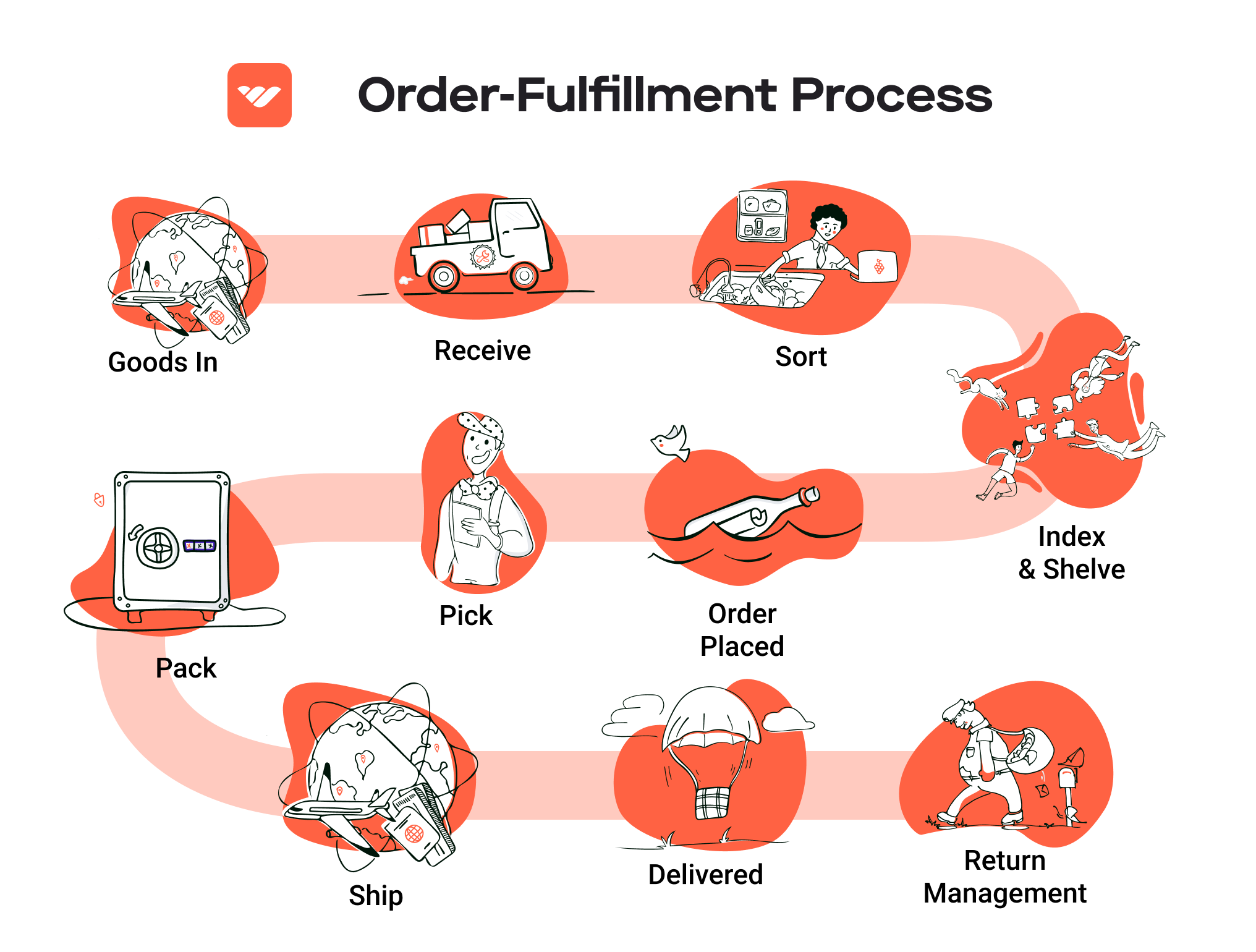
-
Customer Service: Amazon also manages customer service and returns for FBA orders. This means sellers don’t have to worry about handling customer inquiries or processing returns, as Amazon’s customer service team is available to assist.
Pros of Using Amazon FBA
1. Prime Eligibility
One of the standout benefits of FBA is that products fulfilled by Amazon are eligible for Amazon Prime. This means that Prime members can enjoy fast, free shipping, significantly increasing the likelihood of sales. The Prime badge adds a layer of trust and credibility to your products, making them more appealing to customers.
2. Enhanced Customer Trust
With FBA, your products benefit from Amazon’s established reputation for reliability and customer service. Customers often feel more secure purchasing items fulfilled by Amazon because they trust Amazon’s return policies and customer support, leading to higher conversion rates.
3. Multi-Channel Fulfillment
FBA isn’t limited to just Amazon.com. Sellers can use FBA to fulfill orders from other sales channels such as eBay, Shopify, and their own websites. This multi-channel fulfillment capability allows businesses to streamline their logistics while maintaining a consistent customer experience across platforms.
4. Scalability
FBA allows sellers to scale their businesses without the need for significant investment in infrastructure. Amazon’s extensive logistics network means that as your sales grow, you can rely on Amazon to handle increased order volumes efficiently.
5. Time-Saving
By outsourcing fulfillment to Amazon, sellers can free up their time to focus on other critical areas of their business, such as marketing and product development. This can lead to better overall business performance.
Cons of Using Amazon FBA
1. High Fees
While FBA offers many advantages, it comes with a cost. Amazon charges fees for storage, fulfillment, and additional services. These fees can significantly impact your profit margins, especially for low-cost items. Sellers must carefully calculate whether the benefits of FBA outweigh the costs.
2. Strict Inventory Rules
Amazon has stringent inventory management policies. Sellers must adhere to these rules to avoid penalties, including long-term storage fees for products that do not sell quickly. Managing inventory effectively is crucial to avoid unnecessary costs.
3. Commingling Risks
When you use FBA, your inventory may be commingled with that of other sellers. This means that Amazon may ship a product that is not yours, leading to potential issues with product quality and customer satisfaction. If a customer receives a defective or incorrect item, it can harm your brand’s reputation, even if it was not your fault.
4. Limited Control
Using FBA means relinquishing some control over the fulfillment process. Sellers have limited visibility into how their products are handled and shipped, which can be a concern for those who prioritize branding and customer experience.
5. Complicated Returns Process
While Amazon handles returns, the process can be complicated for sellers. Returned items may not always be in resalable condition, and managing these returns can be challenging. Additionally, sellers may have to deal with inventory discrepancies resulting from returns.
Who is FBA Best For?
Fulfillment by Amazon is ideal for:
-
Small to Medium-Sized Businesses: Sellers looking to scale without investing heavily in logistics will find FBA beneficial. It allows them to focus on sales and marketing while Amazon handles fulfillment.
-
E-commerce Entrepreneurs: New entrepreneurs entering the e-commerce space can leverage FBA to simplify their operations and benefit from Amazon’s vast customer base and established trust.
-
Sellers with High Order Volumes: Businesses that experience high order volumes or seasonal spikes can take advantage of Amazon’s logistics capabilities to meet customer demand without the stress of managing fulfillment.
-
Multi-Channel Sellers: Brands that sell on multiple platforms will benefit from FBA’s multi-channel fulfillment options, allowing them to centralize their logistics under one roof.
In summary, Fulfillment by Amazon offers a comprehensive solution for e-commerce businesses seeking to streamline their logistics and improve their customer experience. While it comes with certain challenges, the advantages, especially for scaling operations, often make it a worthwhile consideration for many sellers.
Core Services Offered by Fulfillment Centers
Inventory Management & Warehousing
Inventory management and warehousing are foundational services provided by fulfillment centers. This process involves storing goods in a dedicated facility where inventory levels are meticulously monitored and managed. Fulfillment centers utilize advanced inventory management systems that track stock levels in real-time, ensuring that e-commerce businesses have a clear view of their inventory status.
Benefits:
1. Space Optimization: By outsourcing warehousing, e-commerce businesses can save on costs related to leasing or maintaining their own storage facilities. This enables them to focus financial resources on growth initiatives rather than infrastructure.
2. Scalability: As order volume fluctuates—whether due to seasonal demand or marketing campaigns—fulfillment centers can easily adjust the storage capacity needed. This flexibility allows businesses to scale operations without the headache of managing physical space.
3. Inventory Accuracy: Automated inventory tracking reduces human error, leading to fewer stockouts and overstock situations. Accurate inventory management helps maintain customer satisfaction by ensuring that products are available when needed.
Pick and Pack Services
The pick and pack service is a critical function in the fulfillment process. It involves selecting the correct items from inventory (picking) and packaging them appropriately for shipment (packing). Fulfillment centers employ efficient workflows and technology, such as barcode scanning, to ensure accuracy and speed in this process.
Benefits:
1. Time Efficiency: Fulfillment centers often have optimized systems and trained personnel that can fulfill orders more quickly than an in-house operation. This results in faster shipping times, which is a significant competitive advantage in e-commerce.
2. Cost Reduction: By outsourcing these services, businesses can save on labor costs associated with hiring and training staff for packing and shipping. Fulfillment centers usually have streamlined processes that minimize labor costs per order.
3. Quality Control: Many fulfillment centers implement quality checks during the pick and pack process, ensuring that the correct items are shipped in good condition. This reduces the likelihood of returns and enhances the customer experience.
Kitting and Assembly
Kitting and assembly are specialized services that involve combining multiple products into a single package or preparing items for sale. This can include bundling products together, assembling components into a final product, or creating promotional kits for marketing purposes.
Benefits:
1. Enhanced Product Offering: Kitting allows businesses to create attractive product bundles that can increase average order value. For example, a beauty brand might bundle a skincare set, encouraging customers to purchase more items at once.
2. Streamlined Operations: By outsourcing kitting and assembly to fulfillment centers, businesses can streamline their operations and focus on core competencies such as product development and marketing. This saves time and resources that can be redirected towards growth.
3. Inventory Management: Kitting can also help manage inventory more effectively by reducing the number of individual SKUs that need to be tracked. This simplification can lead to a more efficient inventory system and lower holding costs.
Returns Management (Reverse Logistics)
Returns management, often referred to as reverse logistics, is the process of handling returned goods. Fulfillment centers offer services to manage returns efficiently, including inspecting returned items, restocking them if they are in sellable condition, and processing refunds or exchanges.
Benefits:
1. Customer Satisfaction: Efficient returns management is crucial in e-commerce, where customers expect hassle-free return processes. Fulfillment centers can handle returns quickly, improving customer satisfaction and loyalty.
2. Cost Efficiency: Managing returns in-house can be resource-intensive. Outsourcing this function allows businesses to save on labor costs and reduce the complexity of handling returns, especially during peak shopping seasons.
3. Data Insights: Fulfillment centers often provide analytics on returns, helping businesses understand why products are returned. This data can inform product improvements, marketing strategies, and inventory management, ultimately reducing future return rates.
By leveraging these core services offered by fulfillment centers, e-commerce businesses can improve their operational efficiency, enhance customer satisfaction, and scale effectively in a competitive marketplace. Each service plays a vital role in streamlining processes, reducing costs, and allowing entrepreneurs to focus on growing their brands.
How to Choose a Fulfillment Partner: A 6-Point Checklist
Location & Warehouse Network
Importance: The geographical location of your fulfillment partner’s warehouses can significantly affect shipping times and costs. A partner with warehouses strategically located near your target customer base can ensure faster delivery and lower shipping expenses.
Questions to Ask:
– Where are your warehouses located, and how does that impact shipping times to my primary customer demographics?
– Do you have multiple warehouses to distribute inventory for faster delivery?
– What shipping carriers do you partner with, and how does that influence shipping costs and options?
Technology & Integrations
Importance: Seamless technology integration is crucial for efficient order processing, inventory management, and real-time tracking. A partner with robust technology can help minimize errors and streamline operations.
Questions to Ask:
– What technology do you use for order management, and how does it integrate with my existing e-commerce platform?
– Can you provide real-time inventory tracking and order status updates?
– Are your systems capable of alerting me when inventory levels fall below a certain threshold?
Specializations (e.g., Cold Storage, Oversized Items)
Importance: Different businesses have unique fulfillment needs, such as handling perishable goods, oversized items, or fragile products. Choosing a partner with the right specializations ensures that your products are stored and handled correctly.
Questions to Ask:
– What specific types of products do you specialize in handling (e.g., cold storage, fragile items)?
– Are there any limitations regarding the size, weight, or nature of the products you can fulfill?
– How do you ensure that specialized items are stored and shipped in compliance with safety and quality standards?
Scalability & Capacity
Importance: As your business grows, your fulfillment partner should be able to scale operations accordingly. Whether it’s accommodating seasonal spikes in demand or sudden growth, having a partner that can handle increased volume is critical.
Questions to Ask:
– How do you manage increased order volume during peak seasons?
– Can you easily adjust your capacity to meet sudden spikes in demand?
– What measures do you have in place to ensure consistent service quality as order volume increases?
Pricing and Contracts
Importance: Understanding the pricing structure of a fulfillment partner is vital to maintaining profit margins. Hidden fees or unfavorable contract terms can significantly impact your bottom line.
Questions to Ask:
– What are your pricing structures, including setup fees, storage fees, and per-order fulfillment fees?
– Are there minimum monthly requirements, and what happens if I don’t meet them?
– Can you provide a transparent breakdown of all potential costs involved in your services?
Customer Support & Reviews
Importance: Reliable customer support can make a significant difference in resolving issues quickly and maintaining a smooth operation. Additionally, reviews and testimonials can provide insights into the partner’s reliability and service quality.
Questions to Ask:
– What customer support options do you offer (e.g., phone, email, chat)?
– How quickly can I expect a response to inquiries or issues that arise?
– Can you provide references or testimonials from current or past clients?
Conclusion
Selecting the right fulfillment partner is a pivotal decision for any e-commerce business aiming to scale. By using this checklist, you can ensure that you thoroughly evaluate potential partners against key criteria that align with your operational needs and growth objectives. Remember, a well-chosen fulfillment partner not only streamlines your logistics but also enhances customer satisfaction and contributes to your overall success.
Understanding Fulfillment Pricing: A Breakdown of Common Fees
Initial Setup Fees
Initial setup fees are typically the first costs you encounter when engaging with a fulfillment service. These fees cover the integration of your systems with those of your fulfillment partner. During this phase, the provider will synchronize inventory levels, establish processes for order processing, and set up the necessary technology to manage your orders effectively.
The calculation of initial setup fees can vary widely depending on the complexity of your business and the fulfillment provider’s capabilities. For instance, if your product catalog is extensive or requires specialized handling, expect higher fees. On average, businesses can expect to pay anywhere from a few hundred to several thousand dollars for initial setup. It’s essential to clarify what is included in these fees—some providers may offer discounts on future services if you meet certain volume thresholds.
Receiving Fees
Receiving fees are charged when your inventory arrives at the fulfillment center. These fees cover the costs associated with unloading, inspecting, and organizing your products within the warehouse. The receiving process is crucial as it ensures that your inventory is accurately accounted for and stored correctly.
Typically, receiving fees are calculated based on the number of pallets or items you are sending to the warehouse. For example, a provider may charge a flat rate per pallet or a per-item fee. It’s advisable to ask for a breakdown of these costs, as some providers may offer tiered pricing based on volume, which can significantly impact your overall expenses.
Storage Fees (per pallet/bin)
Storage fees are recurring costs associated with holding your inventory at the fulfillment center. These fees are crucial for businesses to understand, as they can have a substantial impact on your profit margins. Providers generally charge storage fees on a monthly basis, either per pallet or per cubic foot, depending on how your inventory is organized.
The calculation of storage fees can vary based on several factors, including the size and type of your products. For instance, smaller items may be stored more densely, potentially lowering your costs per unit. Businesses should also inquire about minimum storage requirements, as some providers may have a base fee that applies regardless of how much inventory you have stored.
Pick & Pack Fees (per item/order)
Pick and pack fees encompass the labor and materials needed to fulfill each order. This fee is charged for the process of selecting items from storage (picking) and preparing them for shipment (packing). The cost can vary depending on the complexity of your orders and the fulfillment provider’s efficiency.
Pick and pack fees are usually calculated on a per-item or per-order basis. For example, a provider may charge a flat fee for picking a certain number of items, with additional costs for each item beyond that limit. Additionally, packaging materials may incur extra charges, so it’s prudent to clarify what is included in the pick and pack fee and whether there are any additional costs for special packaging requirements.
Shipping Fees
Shipping fees are among the most significant costs associated with order fulfillment. These fees cover the actual transportation of products from the fulfillment center to your customers. Shipping costs can fluctuate based on several factors, including the shipping carrier, the destination, the weight of the package, and the shipping speed selected.
Fulfillment providers typically have contracts with shipping carriers, which can result in discounted rates. However, businesses should be mindful of how these shipping fees are calculated. Some providers may charge a flat rate per order, while others may calculate fees based on weight or dimensional weight (which considers the size of the package). Understanding these nuances can help you optimize your shipping strategy and costs.
Tips for Getting an Accurate Quote
-
Provide Detailed Information: When seeking quotes, be as detailed as possible about your product specifications, order volume, and fulfillment needs. This will enable providers to give you a more accurate estimate.
-
Ask for a Breakdown of Fees: Ensure you receive a comprehensive breakdown of all costs associated with the fulfillment process. Understanding each fee will help you make informed decisions.
-
Consider Long-Term Costs: Look beyond initial setup fees and assess the long-term costs associated with storage, pick and pack, and shipping fees. This will give you a clearer picture of your total fulfillment expenses.
-
Negotiate Terms: Don’t hesitate to negotiate terms with potential fulfillment partners. Many providers are open to adjusting fees based on volume commitments or long-term contracts.
-
Compare Multiple Providers: Finally, compare quotes from several fulfillment services. This not only gives you a better understanding of the market rates but also helps you identify the best fit for your business needs.
By carefully evaluating these common fulfillment pricing models and following the tips outlined above, you can better navigate the complexities of fulfillment costs and make strategic decisions that support your business growth.
Frequently Asked Questions (FAQs) about Fulfillment
1. What is fulfillment in e-commerce?
Fulfillment in e-commerce refers to the process of receiving, processing, and delivering customer orders. It encompasses everything from inventory management to picking, packing, shipping, and handling returns. Effective fulfillment is crucial for ensuring timely delivery and customer satisfaction.
2. What are the types of fulfillment services?
There are several types of fulfillment services available:
– In-house fulfillment: The business manages all aspects of order fulfillment internally.
– Third-party logistics (3PL): A specialized provider handles storage, packing, and shipping on behalf of the business.
– Dropshipping: The retailer sells products that are shipped directly from the supplier, eliminating the need to hold inventory.
3. What’s the difference between a warehouse and a fulfillment center?
A warehouse is primarily used for storage of goods, whereas a fulfillment center is designed specifically for processing and shipping customer orders. Fulfillment centers are equipped with advanced technology to streamline order management and often offer additional services like packing and returns processing.
4. What is a 3PL?
A 3PL, or third-party logistics provider, is a company that offers outsourced logistics services, which can include warehousing, inventory management, order processing, and shipping. Utilizing a 3PL allows businesses to focus on their core operations while benefiting from the expertise and infrastructure of a logistics specialist.
5. How much do fulfillment services cost?
The cost of fulfillment services varies widely based on several factors, including the provider, the volume of orders, and the specific services required. Common costs include setup fees, storage fees (often charged per pallet or cubic foot), picking and packing fees, and shipping fees. It’s crucial to evaluate potential vendors and understand their pricing structures before committing.
6. How does the fulfillment process work?
The fulfillment process typically follows these steps:
1. Order receipt: An order is placed by a customer through the e-commerce platform.
2. Inventory check: The system verifies that the items are in stock.
3. Picking: Warehouse staff select the items from inventory.
4. Packing: The items are packaged securely for shipping.
5. Shipping: The package is dispatched to the customer via a chosen carrier.
6. Delivery confirmation: The customer is notified that their order is on its way.
7. What are the benefits of using a fulfillment service?
Using a fulfillment service can provide numerous benefits, including:
– Scalability: Easily adjust to changing order volumes without the need for additional infrastructure.
– Cost-effectiveness: Reduce overhead costs associated with maintaining a warehouse and hiring staff.
– Focus on core business: Free up time to focus on marketing, sales, and customer engagement instead of logistics.
– Expertise: Benefit from the knowledge and experience of logistics professionals.
8. How can I choose the right fulfillment partner?
To choose the right fulfillment partner, consider the following factors:
– Scalability: Ensure they can handle your current and future order volumes.
– Technology integration: Look for systems that can seamlessly integrate with your existing e-commerce platform.
– Capabilities: Verify that they can meet your specific product needs, including weight, size, and packaging requirements.
– Cost structure: Understand their pricing and any potential hidden fees.
9. What role does technology play in fulfillment?
Technology plays a crucial role in streamlining the fulfillment process. It helps manage inventory, track orders, optimize shipping routes, and provide real-time updates to both the business and the customer. Implementing a robust fulfillment system can significantly enhance efficiency and accuracy.
10. How do returns work in the fulfillment process?
Returns management is a critical component of the fulfillment process. A good fulfillment service should handle returns by:
– Processing incoming return shipments.
– Verifying the return against the business’s return policy.
– Issuing refunds or exchanges as necessary.
– Restocking eligible items back into inventory to ensure availability for future orders.
Conclusion: Is Outsourcing Fulfillment the Right Move for Your Business?
Evaluating the Benefits of Outsourcing Fulfillment
Outsourcing your fulfillment can significantly enhance your e-commerce operations, allowing you to focus on core business activities while leveraging the expertise of specialized fulfillment services. One of the most compelling benefits is time savings. By entrusting order processing, packing, and shipping to a fulfillment partner, you free up valuable hours that can be redirected toward marketing, product development, or customer engagement. This shift not only enhances productivity but also enables you to respond more swiftly to market changes.
Scalability is another critical advantage. As your business grows, so does the complexity of your fulfillment needs. A reputable fulfillment service can seamlessly manage fluctuations in order volume, whether during peak seasons or unexpected surges in demand. This scalability ensures that you maintain service quality without the burdens of hiring additional staff or investing in larger warehouse spaces.
Moreover, outsourcing fulfillment provides access to industry expertise. Fulfillment centers are equipped with advanced technology and efficient processes that improve order accuracy and reduce shipping times. This expertise can lead to better customer experiences, fostering loyalty and repeat business.
However, the success of outsourcing hinges on selecting the right partner. It’s essential to conduct thorough due diligence to ensure that the fulfillment service aligns with your business goals, offers reliable technology integration, and can handle your specific product requirements.
Take Action: Audit Your Current Shipping Process
To determine if outsourcing fulfillment is the right next step for your business, conduct an audit of your current shipping process. Assess your operational bottlenecks, customer satisfaction levels, and growth projections. This analysis will provide clarity on whether a fulfillment partner could enhance your efficiency and support your growth trajectory. Remember, the right partner can be a game-changer in your quest for operational excellence.
Important Disclaimer
⚠️ Important Disclaimer
The information in this guide is for educational purposes. Fulfillment services, pricing, and platform features change frequently. Always conduct your own due diligence and consult with providers directly before making business decisions.
